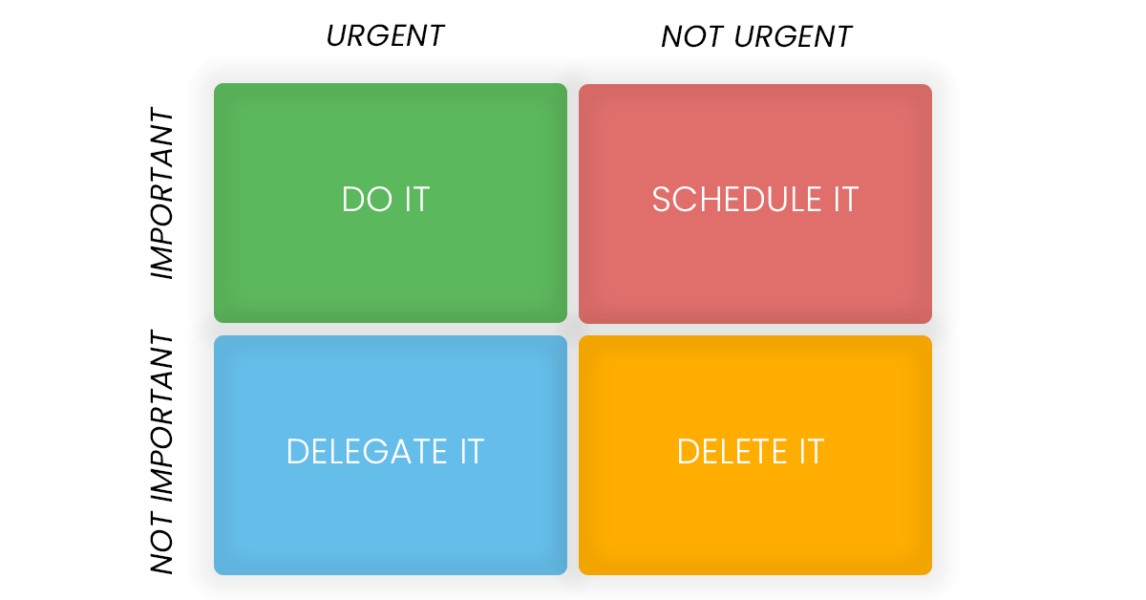Everyone has their tipping point; the moment their workload goes from under control to overwhelming. High pressure professional responsibilities collide with personal stressors, causing overall tension to skyrocket. No matter how much you plan, things compound, and you feel you never have enough time.
However the issue may not be the lack of planning, but the lack of effective planning causing a productivity downfall.
Regardless of if you are an experienced executive managing a large team or just settling in at your first job, one common issue is limited time. Everyone is provided the same 24-hours in a day and those that master efficient time management yield the highest results.
When implementing a time management strategy, it is important to find a realistic, simple process that is manageable long-term. One that sets clear guidelines without utilizing too much time to set up, motivating you to take immediate action.
One commonly used system is the Urgent/Important Matrix, often referred to as The Eisenhower Matrix.
Though not created by Dwight D. Eisenhower himself, he solved problems big and small by answering two questions. Is this task urgent? Is it important?
The History
Between eight years as the 34th President of the United States, becoming a five-star general in WWII, launching space programs, and being held responsible for developing the interstate highway system, it is notable that Dwight D. Eisenhower used his time efficiently.
Individually, his long list of accomplishments is impressive, but viewed in the aggregate his ability to achieve so much in so little time is truly incredible.
In a 1954 speech, Eisenhower quoted Dr. J Roscoe Miller, president of Northwestern University, saying, “I have two kinds of problems, the urgent and the important. The urgent are not important, and the important are never urgent.”
Years later, at the 1961 Century Association, Eisenhower stated “who can define for us with accuracy the difference between the long and short term. Especially whenever our affairs seem to be in crisis, we are almost compelled to give our first attention to the urgent present rather than to the important future.”
These two concepts were blended, given Eisenhower’s namesake, and became one of the most effective time management theories decades later – The Eisenhower Matrix.
The Eisenhower Matrix
This time management theory, made of four quadrants, segregates tasks based on the urgency and importance of each duty.
Urgent vs Not Urgent
Important vs Not Important
Urgent tasks are time-sensitive responsibilities whereas important tasks lead to long term growth.
Urgent activities demand immediate attention. To determine if a task is urgent or not, ask yourself if you or your team will face significant consequences if it is not completed right away. If the answer is no, then the task should be categorized as not urgent. Urgent tasks do not become important just because they are pressing.
Important tasks contribute to the big picture of your role and often get pushed aside when urgent tasks pop up. Important responsibilities are what leave a lasting impact but do not always accompany a hard deadline.

Urgent & Important
These tasks have clear deadlines and consequences when not attended to right away. This category is the highest priority on your to-do list when you begin your workday.
Important & Not Urgent
These are the tasks that are easy to procrastinate on but show long-term success in your role. Schedule time to complete these tasks before they become urgent.
Urgent & Not Important
These tasks are crucial to achieving your goals, but do not necessarily need your specific skill set. These activities can, and should, be done without you.
Not Important & Not Urgent
These distractions should be avoided if possible. Set boundaries and complete these tasks in moderation.
Your Starting Point
The simplicity and scalability of this matrix is what makes it efficient to implement. Clearly defining your tasks gives you a starting point in managing your schedule.
- Start by writing out your to do list. Putting your thoughts on paper will help clear your head to determine how important and urgent each task is.
- Find your system to label and define tasks within each category. Asses what is important and what is urgent.
- Create a plan to complete or delegate tasks within each quadrant and get to work.
Urgent & Important
Strive to complete these tasks today.
Important & Not Urgent
Set realistic deadlines and allocate enough time in your schedule to stay on top of these tasks before they become urgent.
Urgent & Not Important
Delegate tasks when possible or ask for help.
Not Important & Not Urgent
Double check each task to make sure they are not relevant to your role before deleting of your to do list.
Whether setting clear boundaries with family or friends, or streamlining communication and processes within your company, this theory can propel your actions to better balance long-term goals with the short-term side effects.
As you become consistent with your time management skills and feel comfortable with your new routine, you will take on larger projects and increase responsibility within your personal and professional roles.
At Right Way Medical, we challenge our team members to find their preferred method for time management to increase our efficiency and communication cross functionally between departments and satellite offices, allowing our team to better serve our customers across the nation.

